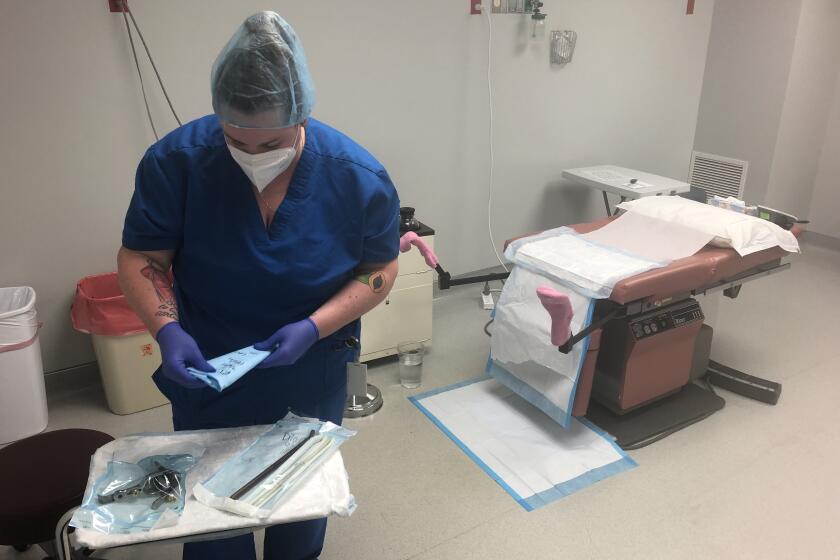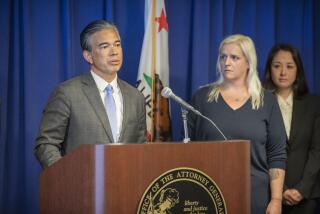Californians have legal rights to abortion, but getting one can be difficult

- Share via
As Texas has strictly limited abortions and lawmakers in other states have pushed to follow suit, liberal leaders have touted California as a longtime stronghold for abortion rights.
California law states that people have a “fundamental right” to choose and obtain an abortion before a fetus becomes viable. The governor has vowed to protect that right.
But just because abortion has more legal protection in California does not mean it is readily accessible to all, advocates of reproductive choice say. Many Californians struggle to afford the procedure, and some live far from a clinic that provides it.
Such practical barriers can make abortion too difficult to access for Californians, despite the legal assurances on the books, advocates say.
“We don’t have as many restrictive laws,” said Onyemma Obiekea, policy analyst for the Black Women for Wellness Action Project, “but we need to recognize all of the hurdles that folks still have to navigate.”
‘No abortion provider for many, many miles’
Some 40% of California counties have no clinic that provides abortions, according to the reproductive health policy organization the Guttmacher Institute, which examined the state’s abortion availability in 2017. Although only a small share of California women were estimated to live in those counties — 3% — that amounts to hundreds of thousands of people.
Little has changed since that analysis, experts say.
“There are large swaths of the state with no abortion provider for many, many miles,” said Dr. Ushma Upadhyay, an associate professor with UC San Francisco’s Advancing New Standards in Reproductive Health research group. Outside of Los Angeles, San Diego and the Bay Area, “they’re very sparse.”
Propelled by a very restrictive abortion law, Texas women are traveling farther afield for abortions.
They can be even sparser for Californians relying on Medi-Cal: In some counties, people seeking an abortion provider that accepts the state Medicaid program have traveled more than 100 miles to access one, according to a study by Upadhyay and other UC San Francisco researchers. For residents of Mono County, on the eastern edge of the state, the median journey was 311 miles.
Low reimbursement rates from Medi-Cal were one reason Women’s Health Specialists, which runs clinics in Redding, Chico and Grass Valley, ended up closing a Sacramento location four years ago, according to Executive Director Katrina Cantrell. Keeping rural clinics open has grown more difficult as abortion rates have fallen. And Cantrell said the group faces “exorbitant” costs for security at its facilities, which have been targeted with firebombs and acid.
“We would have never closed [the Sacramento site] if the economics had allowed us to continue,” Cantrell said.
‘Cost is truly the No. 1 barrier’
California requires commercial health insurers to cover abortions, but many patients seeking to terminate a pregnancy face out-of-pocket costs such as copayments.
“What we see time and time again is that cost is truly the No. 1 barrier to folks when they need to access care,” said Shannon Olivieri Hovis, director of NARAL Pro-Choice California. For instance, she said, young, generally healthy people who haven’t spent down their insurance deductibles may face significant expenses for an abortion.
Laura Morehouse said getting an abortion cost her five weeks of wages when she was employed at a convenience store a decade ago. Morehouse, who was living in the San Francisco Bay Area at the time, said when she first went to a local clinic, she was one day past the window for a medication abortion, which meant her only option was a costlier procedure at a facility farther away.
“I had to continue to delay it until I could come up with the money,” said Morehouse. She ultimately paid nearly $1,000 out of pocket for the procedure.
“Now I know that I would have qualified for pregnancy-related Medi-Cal,” she said. “But nowhere in the process was I told how to apply for that or what it was.”
Medi-Cal does not impose such “cost sharing” for abortions, but private insurers do. For Californians enrolled in health plans regulated by the state, a medication abortion can cost an average of $306 out of pocket, and a procedural abortion can cost $887, along with associated services costing an average of $182, according to an analysis by the California Health Benefits Review Program.
NARAL and other groups that advocate for reproductive choice have backed Senate Bill 245, which seeks to prohibit health insurers from imposing deductibles, copays or other forms of cost sharing on people seeking an abortion in California.
The bill has been opposed by antiabortion religious and advocacy groups, as well as by insurers concerned about coverage mandates. It was held up this fall in the Legislature, delaying a possible vote until next year.
Telehealth could be an option
Besides the cost of the abortion, many patients have to grapple with the expense and challenge of taking time off work, traveling, finding a place to stay and obtaining child care, said Morehouse, who now works as a phone counselor for Women’s Health Specialists.
“We have clients that come to our Chico and Redding locations all the way from the Oregon-California border,” Morehouse said. “Just the travel time is difficult for a lot of people. It’s difficult for mothers. It’s difficult for working people.”
Telehealth, which got a jump-start during the COVID-19 pandemic, has been eyed as a way to expand abortion access. When a person in Inyo County searches for a clinic on Abortion Finder, a website that identifies certified abortion providers, the closest facilities might be in Bakersfield, Fresno or even Las Vegas. But the website also points the person to “virtual providers” who can provide pills by mail and offer medical guidance by video, phone or digital messaging.
Early in the pandemic, a federal judge suspended a U.S. Food and Drug Administration requirement that mifepristone — a key drug used in medication abortion — be dispensed in a medical office, clinic or hospital. That rule was reinstated after the Trump administration appealed the decision, but the Biden administration put it back on hold in April.
Telehealth services can make abortion more accessible in the early stages of pregnancy, when medication abortion is possible. Upadhyay said in some cases, busy patients have been able to hold a video visit with a medical provider from their cars in the middle of the workday.
Money can still be an obstacle, however, and many online providers do not accept insurance. Telehealth is not an option for other forms of abortion or for those further along in pregnancy. And rural areas are less likely to have access to broadband internet to facilitate virtual visits.
‘Expand the workforce’
Abortion rights advocates had hoped, after Roe vs. Wade, that abortion would become “normalized within healthcare,” said UC San Francisco obstetrics and gynecology professor Carole Joffe. Instead, most abortions in the U.S. take place at freestanding facilities rather than at hospitals or community clinics that offer a broader range of medical care, she said.
One obstacle to integrating abortion into such facilities has been the Hyde Amendment, which sharply limits the use of federal funds to pay for abortion. If a community clinic gets federal money, it can find it complicated to separate medical billing for abortions from that of other services, said Dr. Montida Fleming, a Physicians for Reproductive Health fellow.
The federal rule “forces abortion care into becoming an isolated field of medicine,” when it doesn’t have to be, she said.
Some are trying to tackle the shortage of rural providers by training family physicians in abortion care. Abortion training is limited in medical school and in residency; Flor Hunt, executive director of Training in Early Abortion for Comprehensive Healthcare, estimated that less than 6% of family medicine residents are routinely trained in abortion care.
California allows nurse practitioners and nurse midwives to provide some forms of abortion if trained, but nursing programs don’t routinely teach it, said Monica McLemore, a professor of nursing who is also affiliated with UC San Francisco’s Advancing New Standards in Reproductive Health group.
“If you wanted to expand abortion access, you would expand the workforce,” she said.
Even if rural physicians are trained and willing to provide abortions, they may not be able to find a clinic that allows it. Some hospitals with religious affiliations have restrictions on abortion care. And doctors joining a group practice may find that others are opposed to providing abortions at the site or don’t want the stigma and risks of doing so.
Cantrell said Women’s Health Specialists clinics in the northern stretches of the state have relied on traveling physicians.
“We have not been able to retain local physicians because of the fear that in the local community, there isn’t the support,” she said.
McLemore noted that the shortage of abortion providers in rural areas is a symptom of a broader problem. Roughly a third of rural counties in California had no hospital obstetrical units as of 2014, according to research from the University of Minnesota Rural Health Research Center.
“We don’t even have basic healthcare in rural places,” McLemore said.
Times staff writer Sean Greene contributed to this report.
More to Read
Sign up for Essential California
The most important California stories and recommendations in your inbox every morning.
You may occasionally receive promotional content from the Los Angeles Times.












